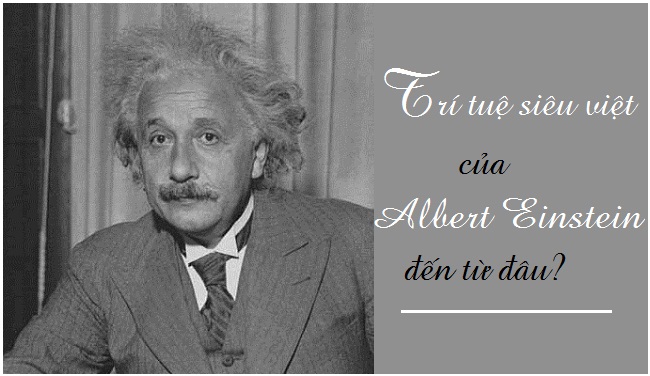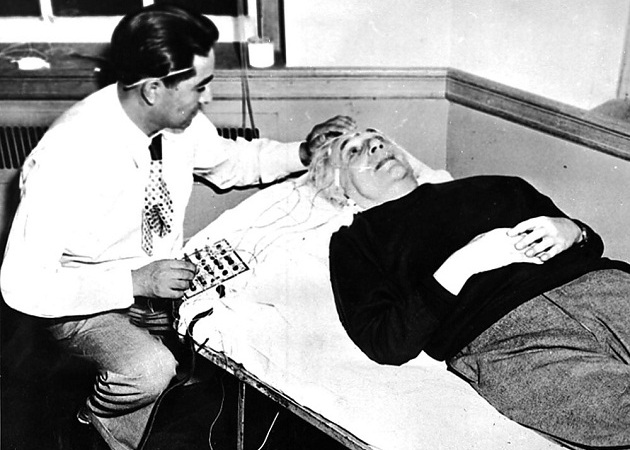The mystery behind the stolen brain of Albert Einstein genius
Albert Einstein died on April 18, 1955 due to aortic rupture. Before taking his last breath, physicist Albert Einstein whispered some German words. But because the nurse at Princeton Hospital did not understand German, Einstein's words were lost forever.
- Albert Einstein exchanged happiness to become a world genius!
- Reveal Einstein's problem solving formula
- How many people can solve the puzzle "Who is a fisherman?" by Einstein

Before his death, Einstein wanted his body to be cremated and sprayed to a secret place. But during his autopsy, his brain was saved by Thomas Harvey, a doctor.
Thomas Harvey persuaded Einstein's son Albert Albert to agree to allow him to do research on Einstein's brain to clarify the secret of genius, one of nature's greatest mysteries.
Harvey weighed Einstein's brain, which weighed 1.22 kilograms, not bigger than any other person of the same age.
 Describe the cortex Albert Einstein.
Describe the cortex Albert Einstein.
After capturing images of the brain, Harvey cut it into 240 small pieces and preserved it in Celloidin, a common chemical in brain preservation and research techniques. Harvey sent small pieces of the brain to the best anatomical research organization in the world today to study the brain.
A long time later, the results of the study were still nothing, Einstein's brain was of normal size and the number of medium-sized brain cells resembled many others.
In 1985, Dr. Marian Diamond, from the University of California, USA, after studying the part of Einstein's brain she noticed the difference: Einstein's brain had a higher rate of glial cells than the other brain.
Glial cells fix nerve neurons, which provide more oxygen and nutrition. Diamond hypothesized that because the metabolic needs of neurons in Einstein's brain were large, the number of glial cells increased to clean up 'waste' during the natural thinking of the celestial body. talent.
But Dr. Diamond's conclusions were quickly rejected by other scientists and not recognized because of unfounded.

The last moments of Albert Einstein's life.
In 1996, Britt Anderson, a researcher at the University of Alabama, USA, published a study on Einstein's anterior cortex. He found that the number of neurons is not different from normal brain, but they are closer together, thus processing information more quickly.
Dr. Sandra Witelson of McMaster University, Canada, who is famous for many brain-related studies, was also asked to study Einstein's brain. After three years of research, she found the lower parietal lobes, the part of the brain related to spatial awareness and Einstein's calculations, was 15% wider than normal people and better integrated. And Witelson said that this particular brain structure was the reason Einstein was stuttering.
Because at that time, scientists did not understand how the brain worked and did not find a brain similar to Einstein's, so it was impossible to verify the accuracy of Dr. Witelson's study.
In 1998, Thomas Harvey awarded 170 parts of Einstein's brain to one of his former associates at Princeton Central Medical University, Dr. Elliot Kraus. In 2007, Thomas Harvey died at the age of 94 and still could not solve the mysteries surrounding Einstein's brain after 40 years of storage.

Part of the brain in a glass jar.(Photo: BBC).
In 2012, anthropologist Dean Falk received the most special point in Einstein's brain that there was an extra wide line in the middle lobe in the brain, which was used to plan and remember. Enstein has up to four lines, while our normal humans have only three lines.
In addition, the cerebral apex of Einstein is asymmetrical and the brain also has a protrusion on the wrinkles. This is called "omega sign", popular among left-handed musicians. In fact, Einstein played the violin.
A year later, Falk and his colleagues realized that the corpus callosum - Einstein's left and right hemispheres, was thicker, creating a more smooth coordination between the two hemispheres.
Scientists believe that Einstein's brain may appear "omega sign" because he often plays violin since childhood. But they could not explain the different characteristics in Einstein's brain due to birth or constituted from the work process.
In fact, all of Einstein's findings on the brain are only theoretical. Scientists admit they are unsure whether the differences in Einstein's brain are closely related to his talent.
You should read it
- 7 valuable life lessons from Albert Einstein
- Albert Einstein's physics genius and 10 profound lessons about life
- Albert Einstein exchanged happiness to become a world genius!
- Reveal Einstein's problem solving formula
- 9 typical examples of spirit that surpasses fate
- Scientific perspective: Can people travel time?
- Albert Einstein was invited by the Israeli government to be President, but he refused
- Is the speed of light slower than assumed in Einstein's theory of relativity?
May be interested
- The mysterious message behind 15 world-famous brand logos that few people know about
 let's explore the messages hidden below 15 world famous logos below!
let's explore the messages hidden below 15 world famous logos below! - Fun facts behind 10 popular technology terms
 why is the device to control the computer pointer named after a small rodent? how is the name of the canned meat used to describe unwanted messages? here's an interesting story behind 10 commonly used tech terms you may not know yet.
why is the device to control the computer pointer named after a small rodent? how is the name of the canned meat used to describe unwanted messages? here's an interesting story behind 10 commonly used tech terms you may not know yet. - How does the 14-year-old boy want to 'change the font' to save $ 400 million for the US to shake up the world now?
 in 2014, the 14-year-old suvir mirchandani wanted to make a plan for the us government to change the font to save hundreds of millions of dollars of printing money every year, making the public in the country 'waving'.
in 2014, the 14-year-old suvir mirchandani wanted to make a plan for the us government to change the font to save hundreds of millions of dollars of printing money every year, making the public in the country 'waving'. - Using a smartphone before bed can make your child obese
 if your child is constantly in the habit of playing games on smartphones before going to bed, he may face the risk of obesity, warning from a new study.
if your child is constantly in the habit of playing games on smartphones before going to bed, he may face the risk of obesity, warning from a new study. - New nanofibers incorporate high durability just launched
 scientists at mit have developed new ultra-strong and sturdy polyethylene nanofibers and can be used in armor parts that are not too bulky.
scientists at mit have developed new ultra-strong and sturdy polyethylene nanofibers and can be used in armor parts that are not too bulky. - Stephen Hawking's life through photos
 a famous british physicist, despite suffering from illness, the wisdom and life of professor stephen hawking always makes the world admire
a famous british physicist, despite suffering from illness, the wisdom and life of professor stephen hawking always makes the world admire






 What do you know about the great genius Albert Einstein
What do you know about the great genius Albert Einstein How many people can solve the riddle 'Who is a fisherman?' by Einstein
How many people can solve the riddle 'Who is a fisherman?' by Einstein Albert Einstein's physics genius and 10 profound lessons about life
Albert Einstein's physics genius and 10 profound lessons about life Albert Einstein exchanged happiness to become a world genius!
Albert Einstein exchanged happiness to become a world genius! Forget the quality of genius, diligence, hard work will help make a great figure
Forget the quality of genius, diligence, hard work will help make a great figure